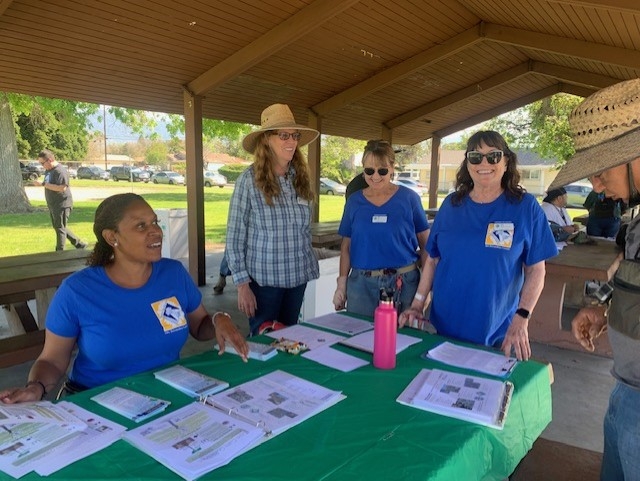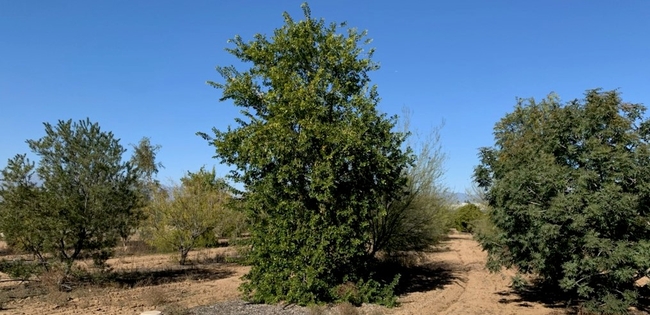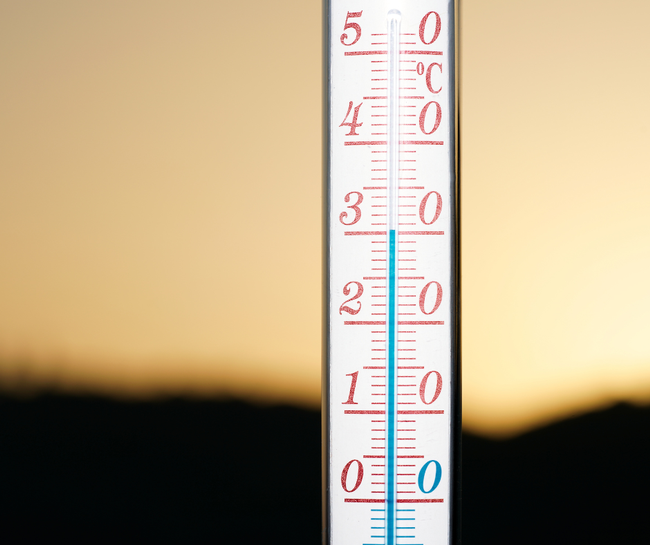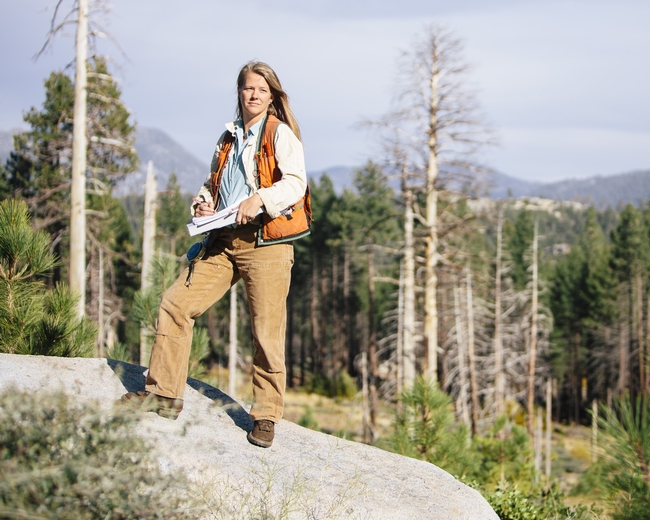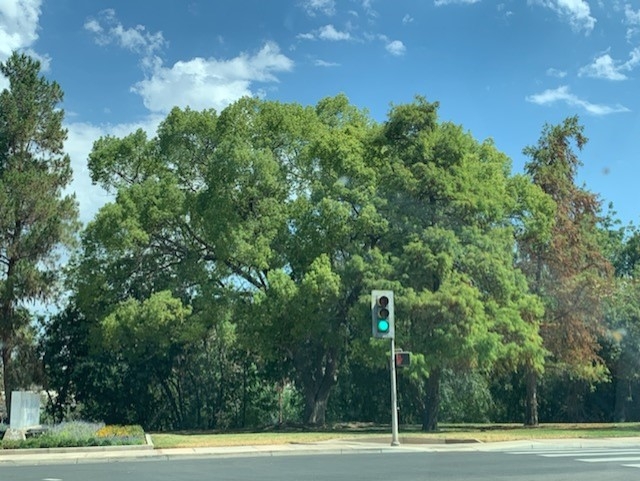
Posts Tagged: heat
The Heat. The Butterflies. The Butterfly Guru.
Don't expect to see UC Davis distinguished professor emeritus Art Shapiro monitoring butterflies on...
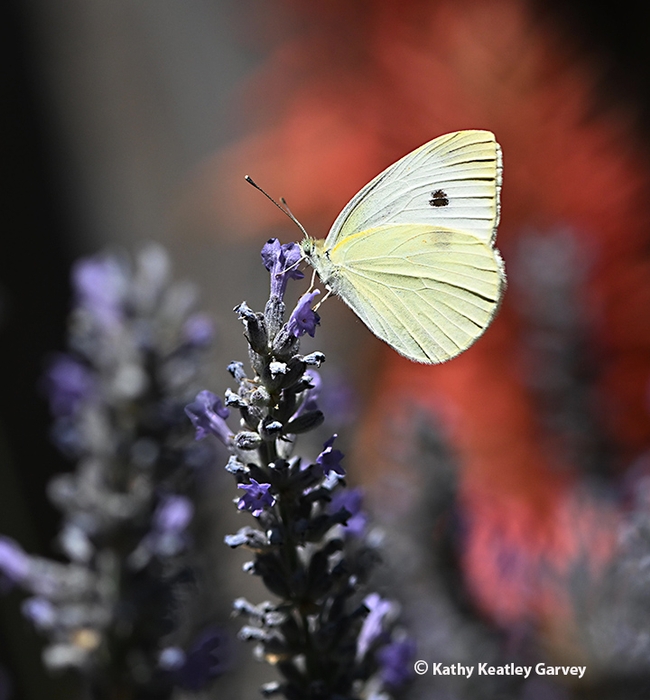
A cabbage white butterfly, Pieris rapae, nectaring on lavender in a Vacaville garden on June 24. Next Wednesday, July 4, promises to be a scorcher at 106 degrees. (Photo by Kathy Keatley Garvey)
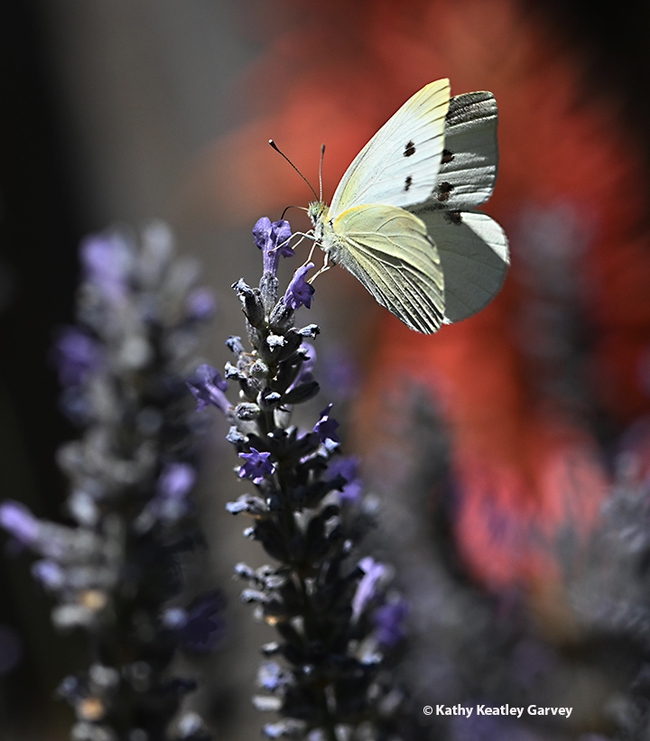
A cabbage white butterfly, Pieris rapae, flutters its wings, ready to fly. (Photo by Kathy Keatley Garvey)
2,000 Climate-Ready Trees Provided to Residents of Low Shade Neighborhoods
To date, over 2,000 climate-ready shade trees and tips on their planting and long-term care have been provided by UC Master Gardeners and over 20 partners to residents of low shade neighborhoods in San Bernardino and Riverside Counties through the “Trees for Tomorrow Start Today” project. Tree species given away are identified from research projects including the joint University of California/United States Forest Service (USFS) study at UC Riverside as well as from other research, local observations, and input from the green industry and academic colleagues.
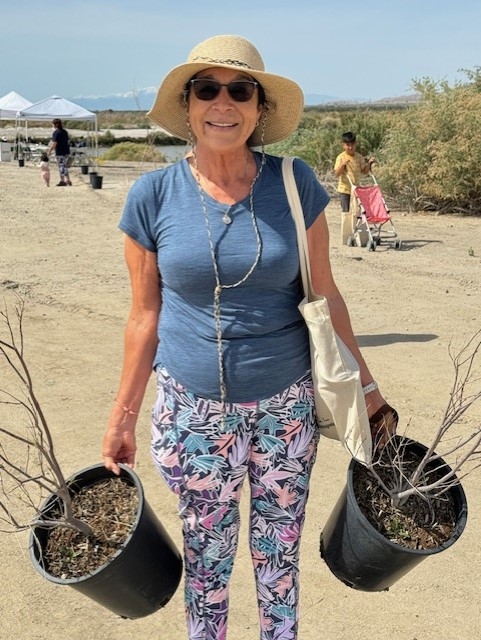
Why is this project so important? 95% of Californians now reside in cities and suburban environments. Resulting urban heat islands created by built environments coupled with impacts of climate change can be mitigated through nature-based solutions. Planting climate-ready shade trees now will help ensure cooler urban areas in the next several decades as trees mature and maximize their urban ecosystem benefits. Fortunately, the shade from a single well-placed tree can decrease surface temperatures of black asphalt and artificial turf by more than 70 degrees F in hot inland and desert cities. Studies show that surrounding air temperatures can also be reduced through the transpiration process.
A major goal of the"Trees for Tomorrow Start Today" project is to enhance tree canopy cover in low shade neighborhoods also plagued with much higher than average levels of air pollution and pulmonary and cardiovascular disease incidence. Events over the past month have occurred in Fontana, San Bernardino, and the Salton Sea.
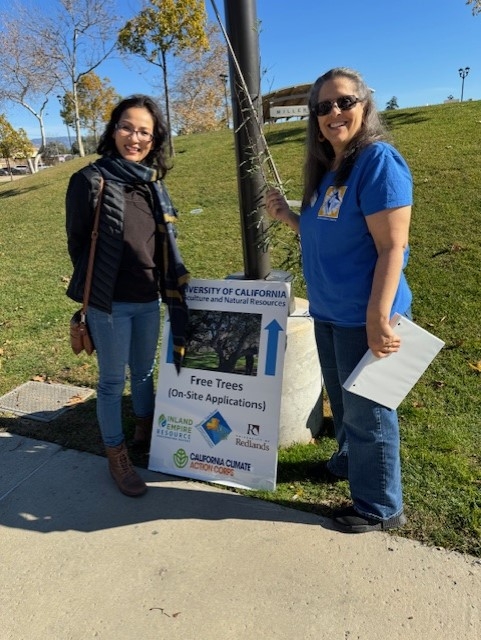
Thank you to all our partners and, especially, our tree recipients, for greening and cooling your yard and neighborhood! 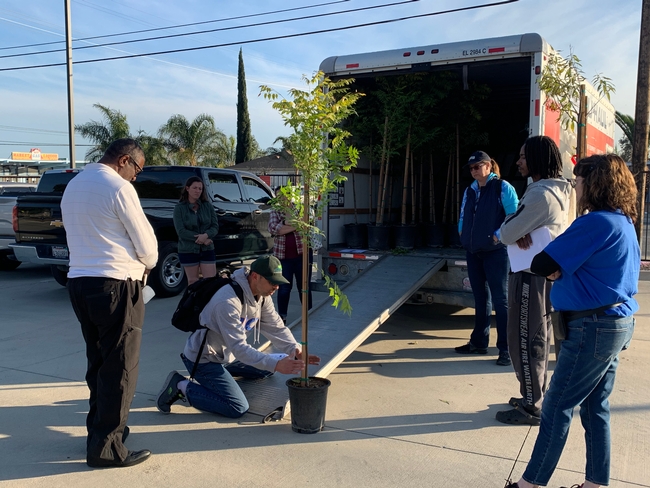
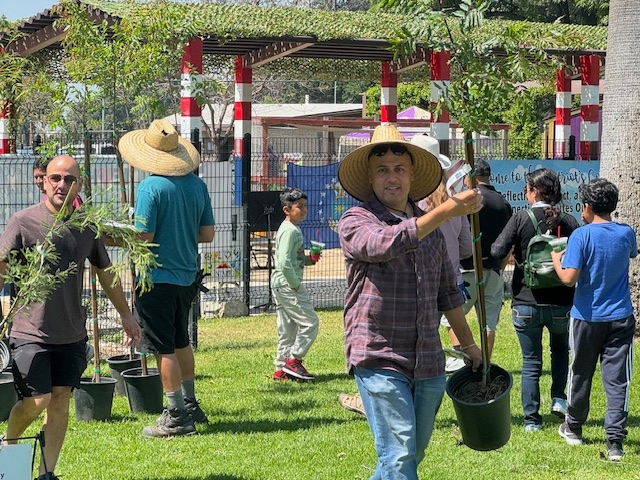
Now is the time to plant climate-ready trees, says UCCE researcher
In a drought-prone region like Southern California, working with Mother Nature is not only wise but necessary, according to Janet Hartin, UC Cooperative Extension horticulture advisor for Los Angeles, San Bernardino and Riverside counties, who studies climate-ready trees.
In 2020, Governor Newsom launched the California Climate Action Corps, empowering Californians to protect their communities from the impacts of climate change. Newsom's call to action emphasizes the need for long-term and sustainable solutions like Hartin's research, which urges Southern California to care for existing trees and plant new ones.
In collaboration with the U.S. Forest Service and other UC Cooperative Extension scientists, Hartin is amid a 20-year research study identifying trees suitable for California's different climate zones. Her work provides a comprehensive understanding of trees and their benefits related to human and environmental health, particularly as Californians navigate climate change's evolving challenges.
One of these concerns is urban heat islands. UHIs are areas in which heat is reradiated from paved concrete or asphalt surfaces. In cities covered in asphalt, like Los Angeles, average temperatures can become six degrees hotter than surrounding areas.
To reduce urban heat islands, she has been working with community organizations to plant trees. In March, for example, Hartin teamed up with the Inland Empire Resource Conservation District to increase tree canopy in the Inland Empire.
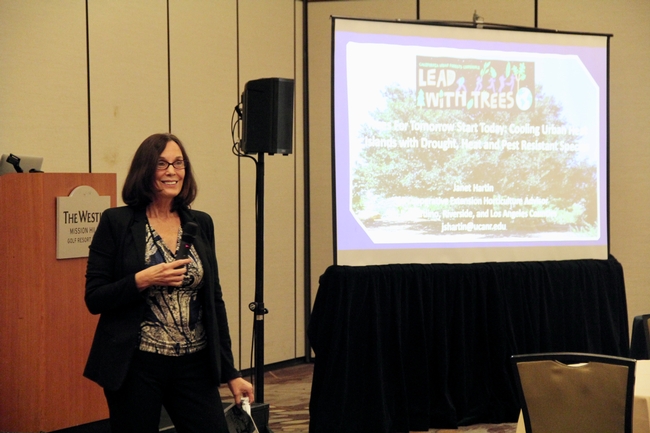
Trees keep cities cool
To keep the city cool, some Los Angeles neighborhoods are repainting pavements with reflective coating. According to a 2020 study published in Environmental Research Letters, reflective coating can decrease pavement temperatures up to 10 degrees. As helpful as this is, augmenting urban landscapes to include heat-, drought- and pest-resistant tree species, whether native or not, can significantly reduce the impacts of urban heat islands too.
“Trees can cool impervious surfaces by 40 to 65 degrees,” Hartin said. During a 2021 study, in May and June Hartin discovered that unshaded asphalt could be more than 60 degrees hotter than shaded asphalt during late spring and early summer in inland and desert cities.
Other than providing shade, trees are effective at deflecting the sun's radiation and cooling the atmosphere through evapotranspiration. Given that they absorb and store carbon as well, trees lessen the impacts of pollution from fossil fuels.
“A well-tended mature landscape tree can absorb 40 tons of carbon over its lifespan,” said Hartin.
In a 2021 blog post, Hartin suggests trees be selected based on their adaptation to the “micro-climate” in each particular landscape, noting factors to consider like shade, proximity to buildings, space needs below and above ground, soil type and water source. She also recommends the Sunset Western Climate Zone maps for reference, noting that they are “more precise than USDA zones for our warmer climates.”
Based on the study with the U.S. Forest Service examining the performance of 12 species of underplanted but promising landscape trees at UC Riverside, favorable candidates include bubba desert willow and maverick thornless honey mesquite for their drought resistance, and red push pistache for its drought and heat resistance.
Tamara Hedges, executive director of UC Riverside Palm Desert Center and member of the Board of Directors for the Oswit Land Trust, agrees that trees are important in our fight against climate change:
“Through our partnerships with the UC California Naturalist and the Master Gardener Programs and many other nonprofits in the Coachella Valley, natural ecosystems are being protected and expanded and built environments cooled through the planting of appropriate tree species. These UC/USFS studies go a long way in identifying new underrepresented tree species."
General tips for planting
For California, planting in early fall through late winter provides ample time for trees to establish a strong root system before enduring the summer heat. Doing so also means that natural rainfall can fulfill water needs, as opposed to solely relying on irrigation systems.
Unlike newly planted trees, mature trees should be watered infrequently but deeply. Watering too often can reduce the level of oxygen in the rootzone and result in waterlogged soils prone to crown and root rots. 
During the fall, trees only need about 15% of the water they would require in the summer. When watering, keep the tree trunk dry. Because the roots of the tree grow outward and are usually a foot deep into the ground, Hartin recommends watering the area around the trunk rather than the trunk itself. This will also help avoid water waste.
“Trees not adapted to the climate they're planted in and not receiving proper care are much more susceptible to invasive pests like shothole borers and diseases,” said Hartin. “Even the loss of one front yard tree can significantly reduce shade, increase the surrounding temperature, and diminish energy savings.”
Disaster resources available to prepare for heat, wildfire, power outages, quakes
September is National Preparedness Month, designated to encourage disaster and emergency readiness. To help Californians prepare for extreme heat, earthquakes, public safety power shutoffs and wildfire, University of California Cooperative Extension has created a disaster preparedness website organized for quick access to critical information.
The website https://ucanr.edu/Disaster contains fact sheets with tips for getting prepared.
“Unfortunately, with a warming climate, we are facing more and more extreme climate-related events such as heat waves, wildfires, power shutoffs and storms. All Californians need to step up their preparedness efforts to be ready to meet this more uncertain future,” said Susan Kocher, UC Cooperative Extension forestry advisor, who co-authored the disaster preparedness resources for the website.
Extreme heat
The fact sheet for extreme heat events offers suggestions for avoiding heat exposure, such as identifying nearby cooling centers and covering windows to keep heat out. It also suggests things to do during hot weather such as staying hydrated, taking cool showers and keeping pets indoors. It describes symptoms of heat-related illnesses, which can have serious health effects.
Public Safety Power Shutoff
During extreme weather events, electrical power in high fire-threat areas may be shut off to prevent sparking. This precaution is known as a Public Safety Power Shutoff. A PSPS is most likely to occur from May to November, when conditions are the hottest and driest.
UC Cooperative Extension recommends signing up to receive PSPS alerts from your energy company. Experts also advise making a plan for medications that need to be refrigerated or medical devices that require power. To prevent foodborne illness, they offer suggestions for ensuring food safety during and after a power outage.
Wildfire and smoke
Wildfire smoke can harm your health. During wildfires, UC Cooperative Extension recommends wearing an N95 outdoors to reduce smoke exposure and taking steps to prevent smoke from entering buildings. To reduce wildfire risk, the website describes methods of removing flammable vegetation around homes.
Earthquakes
UC Cooperative Extension offers safety tips for before, during and after an earthquake. Identifying the safest place in your home during an earthquake in advance is helpful. For example, doorways are not the safest place to be in modern homes. Experts recommend crawling under a sturdy desk or table, while avoiding areas next to windows, beneath ceiling fixtures or near large items that may fall during an earthquake.
The website also offers resources on drought, food safety after a fire, and wildfire preparedness and recovery.
In 2020 and 2021, Cooperative Extension researchers from around the country held listening sessions with community members who had experienced extreme weather events and other types of disasters to learn what had worked well, what had not, and how communities could be strengthened.
In response, these disaster resources were developed by Kocher, UC Davis undergraduate student Caydee Schweitzer, Tracy Schohr, UC Cooperative Extension livestock and natural resource advisor, and Vikram Koundinya, UC Cooperative Extension evaluation specialist. The group plans to add fact sheets on more disaster topics in the future.
This project was funded by a USDA National Institute of Food and Agriculture Renewable Resources Extension Act grant.
MEDIA CONTACT: Susan Kocher, UC Cooperative Extension forestry advisor, sdkocher@ucanr.edu
Climate change resources for Horticulturists, Government Officials, and UCCE Master Gardeners
Climate Change Resources for Horticulturists and UCCE Master Gardeners
Updated by Janet Hartin jshartin@ucanr.edu 8/17/2022
University of California UC ANR Green Blog (Climate Change and Other Topics) https://ucanr.edu/blogs/Green/index.cfm?tagname=climate%20change (full index)
Examples:
- Save Trees First: Tips to Keep Them Alive Under Drought https://ucanr.edu/b/~CdD
- Landscaping with Fire Exposure in Mind: https://ucanr.edu/b/~G4D
- Cities in California Inland Areas Must Make Street Tree Changes to adapt to Future Climate https://ucanr.edu/b/~oF7
Drought, Climate Change and California Water Management Ted Grantham, UC Cooperative Extension specialist (23 minutes) https://youtu.be/dlimj75Wn9Q
Climate Variability and Change: Trends and Impacts on CA Agriculture Tapan Pathak, UC Cooperative Extension specialist (24 minutes) https://youtu.be/bIHI0yqqQJc
California Institute for Water Resources (links to blogs, talks, podcasts, water experts, etc.) https://ciwr.ucanr.edu/California_Drought_Expertise/
UC ANR Wildfire Resources (publications, videos, etc.) https://ucanr.edu/News/For_the_media/Press_kits/Wildfire/ (main website)
UC ANR Fire Resources and Information https://ucanr.edu/sites/fire/ (main website)
Preparing Home Landscaping https://ucanr.edu/sites/fire/Prepare/Landscaping/
UC ANR Free Publications https://anrcatalog.ucanr.edu/ (main website)
Keeping Plants Alive Under Drought and Water Restrictions (English version) https://anrcatalog.ucanr.edu/pdf/8553.pdf
(Spanish version) https://anrcatalog.ucanr.edu/pdf/8628.pdf
Use of Graywater in Urban Landscapes https://anrcatalog.ucanr.edu/pdf/8536.pdf
Sustainable Landscaping in California https://anrcatalog.ucanr.edu/pdf/8504.pdf
Other UC (Non-ANR) scientists
Daniel Swain (UCLA): website: https://weatherwest.com/ twitter: @Weather_West
Non-UC Climate Change Resources
Urban Forests and Climate Change. Urban forests play an important role in climate change mitigation and adaptation. Active stewardship of a community's forestry assets can strengthen local resilience to climate change while creating more sustainable and desirable places to live. https://www.fs.usda.gov/ccrc/topics/urban-forests
Examining the Viability of Planting Trees to Mitigate Climate Change (plausible at the forest level) https://climate.nasa.gov/news/2927/examining-the-viability-of-planting-trees-to-help-mitigate-climate-change/
Reports and other information resources coordinated under the auspices of the United Nations and produced through the collaboration of thousands of international scientists to provide a clear and up to date view of the current state of scientific knowledge relevant to climate change. United Nations Climate Action
Scientific reports, programs, action movements and events related to climate change. National Center for Atmospheric Research (National Science Foundation)
Find useful reports, program information and other documents resulting from federally funded research and development into the behavior of the atmosphere and related physical, biological and social systems. Search and find climate data from prehistory through to an hour ago in the world's largest climate data archive. (Formerly the "Climatic Data Center") National Centers for Environmental Information (NOAA)
Think tank providing information, analysis, policy and solution development for addressing climate change and energy issues (formerly known as the: "Pew Center on Global Climate Change"). Center for Climate & Energy Solutions (C2ES)
Mapping Resilience: A Blueprint for Thriving in the Face of Climate Disaster. The Climate Adaptation Knowledge Exchange (CAKE) was launched in July 2010 and is managed by EcoAdapt, a non-profit with a singular mission: to create a robust future in the face of climate change by bringing together diverse players to reshape planning and management in response to rapid climate change. https://www.cakex.org/documents/mapping-resilience-blueprint-thriving-face-climate-disaster
Cal-Adapt provides a way to explore peer-reviewed data that portrays how climate change might affect California at the state and local level. We make this data available through downloads, visualizations, and the Cal-Adapt API for your research, outreach, and adaptation planning needs. Cal-Adapt is a collaboration between state agency funding programs, university and private sector researchers https://cal-adapt.org/
Find reports, maps, data and other resources produced through a confederation of the research arms of 13 Federal departments and agencies that carry out research and develop and maintain capabilities that support the Nation's response to global change. Global Change (U.S. Global Change Research Program)
The Pacific Institute is a global water think tank that combines science-based thought leadership with active outreach to influence local, national, and international efforts to develop sustainable water policies. https://pacinst.org/our-approach/
Making equity real in climate adaptation and community resilience policies and programs: a guidebook. https://greenlining.org/publications/2019/making-equity-real-in-climate-adaption-and-community-resilience-policies-and-programs-a-guidebook/
Quarterly CA Climate Updates and CA Drought Monitor Maps (updated each Thursday) https://www.drought.gov/documents/quarterly-climate-impacts-and-outlook-western-region-june-2022

